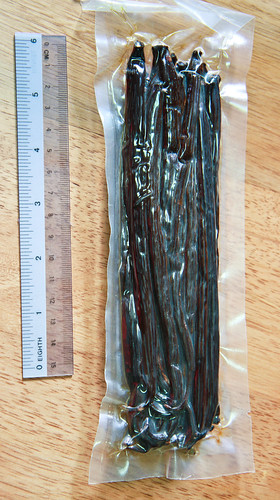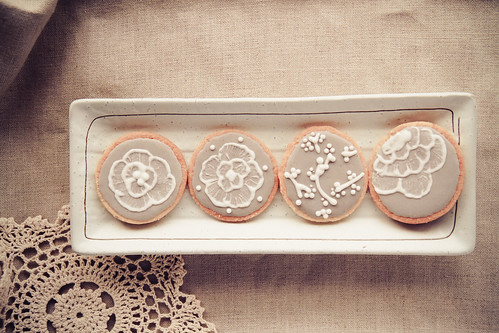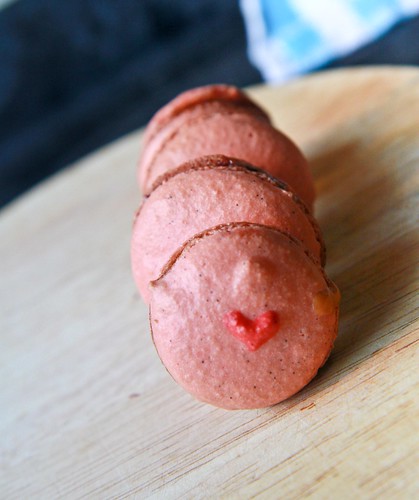I can finally tick off the Great Ocean Road from my 'places to visit' list. It's sort of a half-tick, because I didn't exactly manage to visit all the sights that I had wanted to visit, and we only reached Port Campbell before doing a U-turn, because reality had to butt its ugly head in and I had to rush to Melbourne CBD to get some urgent documents couriered back to Singapore. Sigh. The fates were just against me that week. What happened earlier was that the car rental company had upgraded us to this huge MPV (a Toyota Kluger), and this was not a welcome upgrade because the height of the car from the ground coupled with the winding roads made me carsick :/
That's a photo of the famed Twelve Apostles along GOR - I think two of the Apostles are missing from the above photo because of the vantage point I was at, and in any case, there was never Twelve Apostles to begin with (did you know that?) The photo, on greater inspection, is rather blurry, but I would like to blame the horrendously cold weather for my shaking hands - I was crazy and decided to visit the Twelve Apostles at sunrise, so it was 6am, freakingly cold and windy (it was 10 deg and I was severely underdressed).
The Great Ocean Road is indeed breathtaking, and I would definitely revisit, although this time in Spring and preferably in a convertible ;) I'll be writing more in a Travel Tuesday entry, because I've lots more to say about the Great Ocean Road. Suffice to say that it's worth spending more than two days leisurely driving along the GOR and I would definitely recommend staying in Apollo Bay - the accommodations I stayed in were not only cheap but one of the best I've stayed in so far!
***
I also wanted to post a short post on some vanilla beans I've received in the mail some time back. I've been waiting for the vanilla extract to 'mature' before I post about the beans :] As you might know, vanilla beans cost a bomb (in Singapore or Malaysia) - I've seen them retailing at about S$5 per bean? Naturally, I was dissatisfied with the prices here and I was pleasantly surprised when I found that there was a cheap source of vanilla beans online! Java Vanilla (you can check them out here or here) is a vanilla plantation in West Java selling its own organic vanilla beans and other vanilla products! (Do note that I'm not too sure about how the organic label works in Indonesia so take that with a pinch of salt). Prices are also pretty reasonable - my pack of 'gourmet java vanilla bean' costs US$30 (S$38/RM95) per 100g pack, inclusive of a trackable postage (to either Singapore or Malaysia). The only drawback is perhaps the fact that you have to have a Paypal account to send the money over.
What I liked about Java Vanilla is the fact that they ship really quickly - I got my beans about 4 days after I received the tracking number Another plus was the fact that the vanilla beans were properly vacuumed sealed, which meant that the vanilla scent and beans would last longer. I have previously received vanilla beans simply put in a plastic bag in an envelope to be shipped across the world from some eBay sellers. The vanilla aroma probably disappeared halfway around the world :/ And to think that I paid much more per bean for those :/
If you check their website, they have a few types of vanilla beans available - the 'luxury' bean which is about 19cm or longer, the 'gourmet' which is about 18cm (this is the one I got) and the 'premium' which is about 16cm. Because the beans are packed based on weight, you will get varying amounts of beans depending on the type you buy. I got about 30 beans for my 'gourmet' pack.
I also did my research prior to buying these beans, because honestly, I was quite doubtful about vanilla beans from Indonesia, but I must say that I was pleasantly surprised. The beans are perhaps one of the oiliest ones I've encountered, but the aroma is fantastic! Ramada, the contact person for Java Vanilla, was really patient with all my queries about the vanilla beans. I was informed that the vanilla beans are the same variety as the ones in Madagascar (Planofilia), and that they use the same curing technique as in Madagascar. However, these retail in the international market as "Bourbon Java Vanilla". I happen to have the Tahitian, Indian and Madagascar vanilla beans in my pantry, and I must say that these Indonesian beans really do resemble the Madagascar ones in aroma (but not in terms of oiliness). There are slight differences though, which I am not able to exactly pinpoint - the Indonesian beans smell a little more pungent(?) but I know for a fact that this pungency will translate very well in custards and other batters.
So, what did I do with my vanilla beans? I made more homemade vanilla extract with them, and after the vodka turned a deep dark shade of brown, I took out some of the vanilla beans to make vanilla sugar! :] (I was inspired by a post I saw on Java Vanilla's webpage on vanilla powder, which was simply vanilla pods ground into powder.)
Typically, homemade vanilla sugar can be made by simply placing a vanilla pod in a jar of sugar and letting it sit for about a week. The sugar will smell fantastic by then. But I wanted to go a step further and extract more vanilla goodness from the pod (to make it worth its value), so what I did was to re-use the beans I had used for the vanilla extract. I placed about 10 vanilla beans in 500g of granulated sugar, and gave it a few blitzes in my food processor. My food processor is rather blunt, so there's still a lot of 'fibre' from the beans left ungrounded (as you can see from the photos). A commercial blender would definitely be able to make full use of the entire vanilla bean by blitzing the pod into smithereens but I had to use a fine sieve to sieve out the fibre. And after doing that, what you have left is DELICIOUS vanilla sugar!
The sugar I used was originally white and refined, so you can see how much vanilla-ness I managed to extract from a single bean, judging from the brownness and spottiness of my homemade vanilla sugar :D There are still some fibers left in the vanilla sugar, so the sugar needs another round of sieving when it is slightly drier - the sugar turned a little wet because of the vodka from the vanilla beans and from the blunt processor.
It took me no longer than 10 minutes to take the vanilla beans out of the vanilla extract, place it into the food processor with the sugar, blitz and sieve it. It's that easy, and now that I have 500g worth of it, I no longer have to waste money buying vanilla sugar from anyone and I am saved the trouble of having to take out a single vanilla pod, slice it into two and remove the 'caviar' whenever the recipe calls for it because I can simply replace some of the sugar with my vanilla sugar! :]
There's no recipe for this, but just a simple ratio of 10 beans to 500g of sugar. You can definitely use more or less vanilla beans if desired.
Here's a tiny sneak peak of where some of the vanilla sugar went to - vanilla sugar cookies!
If any of you are interested in trying out the vanilla beans, be sure to check out Java Vanilla (or email Ramada directly at his email address - their beans are pretty darn decent and at $1 per bean, it's really value for money! For those of you not willing to shell out S$37/RM95 for a entire pack of beans (it's not that much for an investment but well), I'm more than willing to mail a bean or two to you, just drop me an email :]
Disclaimer: This 'promotion' was not warranted for by Ramada/Java Vanilla, but I was very impressed with their service and their products - hence this post. I did however, receive a small pack of complimentary beans for my order, but all thoughts and content above remain my own.






















